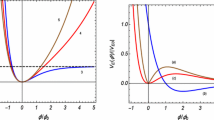Summary
The concept of the inertial frame of the Universe is discussed and its possible evolution treated within a causally symmetric framework modelling the empty cosmos as the universal maximal one. A simple theoretical description of the evolution in terms of a stochastic process dependent on a single parameter, which would be in principle observable, is proposed. It is invariant under the full 15-parameter causal group\(\widetilde{SU}_{2.2} /Z_2 \) of the Einstein universe, to which the universal cosmos is conformally equivalent.
Riassunto
Si discute il concetto di sistema inerziale dell’Universo e si tratta la sua possibile evoluzione nell’àmbito di un sistema causalmente simmetrico che modella cosmi vuoti come quello universale massimale. Si propone una semplice descrizione teorica dell’evoluzione in termini di un processo stocastico che dipende da un parametro singolo che sarebbe, in linea di principio, osservabile. Essa è invariante secondo il gruppo completo causale a 15 parametri\(\widetilde{SU}_{2.2} /Z_2 \) dell’universo di Einstein, al quale il cosmo universale è conformenente equivalente.
Резюме
Обсуждается концепция инерциальной системы Вселенной. Рассматривается возможная эволюция в причнино симметричном нодходе. Предлагается простое теоретическое описание эволюции в терминах стохастического процесса, зависящего от единственного параметра, который, вообще говоря, может быть наблюдаемым. Этот подход является инвариантным относительно полной 15-параметрической причинной группы\(\widetilde{SU}_{2.2} /Z_2 \) Вселенной Эйнштейна, в которой универсальный космос является конформно эквивалентным.
Similar content being viewed by others
References
I. E. Segal:Int. J. Theor. Phys.,21, 851 (1982), and references therein.
C. F. von Weizsäcker:Br. J. Philos. Sci.,24, 321 (1973), and additional references given in his contributions to the series of conferences inQuantum Theory and the Structures of Time and Space, Vol.3 (Munich, 1978); cf. alsoI. E. Segal inQuantum Theory and the Structures of time and Space, Vol.2 (Munich, 1977), p. 113.
I. E. Segal:Maxwell’s influence on geometry, inProceedings of the Symposium on the 150th Anniversary J. C. Maxwell, Amherst, Mass., October 1981, in press.
A. D. Alexandrov andV. V. Ovchinnikova:Vestn. Leningr. Univ.,11, 95 (1953);E. C. Zeeman:J. Math. Phys.,5, 490 (1964);M. Flato andD. Sternheimer:C. R. Acad. Sci. (Paris), Ser. A,263, 935 (1966).
J. L. Tits:Colloque sur la théorie de la relativité, Centre Belge Recherches Mathématiques (1960), p. 107;Bull. Soc. Math. Belg.,31, 171 (1979).
E. Vinberg:Tr. Mosk. Nat. Obsc.,12, 303 (1963).
S. M. Paneitz andI. E. Segal:J. Funct. Anal.,47, 78 (1982);49, 335 (1982).
J. F. Nicoll, I. E. Segal, D. Johnson andW. Segal:Proc. Natl. Acad. Sci. U.S.A.,77, 6275 (1980);J. F. Nicoll andI. E. Segal:Proc. Natl. Acad. Sci. U.S.A.,79, 3913 (1982);Astron. Astrophys.,118, 180 (1983).
I. E. Segal:Astron. Soc. Jpn. Publ.,34, 507 (1982);P. S. Osmer:Astrophys. J.,253, 28 (1982);B. E. Peterson, A. Savage, D. L. Jauncey andA. E. Wright:Astrophys. J.,260, L27 (1982);E. J. Wampler, L. B. Robinson, E. M. Burbidge andJ. A. Baldwin:Nature (London),243, 336 (1973).
J. F. Nicoll andI. E. Segal:Astron. Astrophys.,115, 398 (1982).
I. E. Segal:Proc. Natl. Acad. Sci. U.S.A.,73, 669 (1976).
Author information
Authors and Affiliations
Additional information
This work is dedicated to Dr.C. F. von Weizsäcker on the occasion of the 1982 Tutzing Conference onQuantum Theory and the Structures of Time and Space.
Traduzione a cura della Redazione.
Переведено редакцией.



